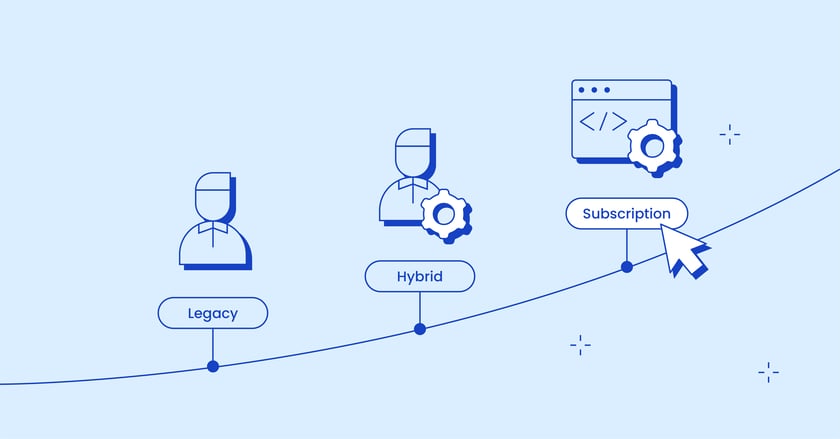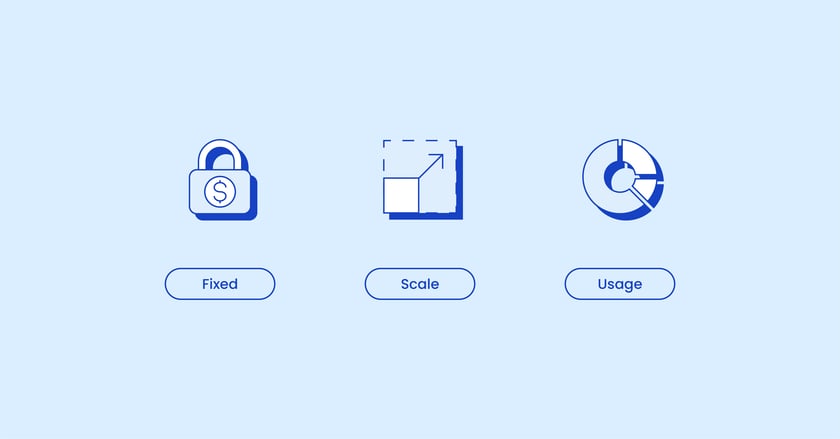Business models shaping the future of hardware
by Zachary Kimball on April 25, 2023
Hardware-as-a-service (HaaS) is the future of hardware sales. HaaS models are growing in prevalence and popularity for good reason. HaaS creates recurring revenue, stickier relationships with customers, and the opportunity to sell to a new customer base. Manufacturers frequently ask about what makes a hardware-as-a-service model, as well as what the pieces are that define a HaaS solution. But what is the sales structure that defines HaaS?
HaaS is actually broader than most people think—an OEM doesn’t need a full-blown pay-by-the-hour implementation to be on the path to HaaS. Several different business models fall clearly on this path.
Sales models
The first thing to consider is the decision around which sales model to use, sometimes called the “capex vs opex” tradeoff—this is how the entire offering will be sold. For each model, there are 2 key questions to consider. First, who retains ownership of the asset? Second, are there any recurring fees?

There are 3 general sales models used in the equipment industry:
Legacy equipment sales model
A “legacy” equipment sales model is framed entirely around capex, or capital expenditure. In this model, the buyer becomes the owner of the asset and there are no recurring fees. This is not hardware-as-a-service.
- Asset ownership: Buyer (either a sale or capital lease) 🏗️
- Recurring fees: No ❌
- Hardware as a service? No❌
Hybrid recurring sales model
The next step that most equipment manufacturers take as they modernize is to offer a “half & half” or hybrid recurring model, including capex up front along with ongoing opex, or operating expense. In these models, the buyer owns the asset but pays recurring fees for software, service, or warranty coverage. This is the beginning of hardware-as-a-service models, where the recurring fee structure is required to achieve maximized value from the hardware.
- Asset ownership: Buyer (either a sale or capital lease) 🏗️
- Recurring fees: Yes ✅
- Hardware as a service? Yes ✅
Full subscription sales model
- Asset ownership: Seller (either an operating lease or rental) 🏭
- Recurring fees: Yes ✅
- Hardware as a service? Yes ✅
Billing models
The next thing to consider is the decision around which billing model to use, sometimes called the pricing structure. This decision focuses on how individual pieces of the offering will be charged for. Figuring out how to select the right price for your solution is another topic altogether.

There are 3 general billing models used to structure HaaS contracts. All 3 of these models only apply to hybrid recurring and to full subscription sales models.
Fixed-fee billing model
A fixed-fee billing model is structured around a set price. This price may be fixed for an individual asset, for an individual software license, or other product line that is part of the solution (such as warranty or service plan). Depending on the package, there may even be a single fee for a full solution (usually known as a bundle). These fees are often annual, but can also be charged monthly or quarterly depending on the installation.
- Example price structures: $500/month for a robot; $10,000/year for a 3D printer; $1,000/month for a service plan
- Example companies: Locus Robotics, Fox Robotics, Gather AI, Pickle Robot Company
- Note: when companies use a fixed-fee model per asset or per seat, contract sizes vary based on the number of assets or seats selected. This structure is different than a scale-based model where the prices of assets themselves can vary based on the scale of the installation.
Scale-driven billing model
A scale-driven billing model is structured around a variable price that is scaled and then locked for the contract duration. A single price is selected based on the scale of the solution required. As a result, during contract discussions this model looks similar to a usage-based model. Over time, the model bills similar to a fixed-fee model.
Scale-based models are usually used when hardware can vary in size imprecisely or non-linearly relative to the scope of the project or installation. For example, deploying warehouse robotics for parcel-moving involves meaningful baseline cost in the racking system, which is complemented by cost for the conveyor system that can vary significantly depending on warehouse square footage. These types of systems can also be very complicated to account for, making a scaled pricing structure even more important.
- Example price structures: $0.25/month per building square foot; $0.50/month per gallon volume commitment; $1.00/month per 1,000 units throughput capacity
- Example companies: Meter, Boxbot, SpotAI, HydroFloTech, Berkshire Grey
Usage-based billing model
- Example price structures: $18.00 per hour; $0.02 per pick; $1.20 per linear foot
- Example companies: Tutor Intelligence, Vicarious, Edge AI, Robotic Maintenance Vehicles, Stenon
Current and future trends
The hardware industry today is on a similar trajectory to the journey that the software industry took with software-as-a-service (SaaS). HaaS is increasing in popularity, with movement towards subscriptions and away from the legacy sales model. But hardware sellers are still learning how to sell a HaaS deal, and buyers are still adjusting to how and why to buy HaaS. In many cases, sellers are fumbling the pitch and buyers are protesting the recurring model! This transition parallels the growing pains of the SaaS transition, as well as the early days of the first HaaS product lines in IT managed services.
Sales models: today and tomorrow
Most of the hardware market currently operates a legacy equipment sales model. Companies are motivated to move to full subscription due to the economic benefits, customer value creation, product stickiness, and opportunity for improved equity multiples. But the jump from a legacy model to a full subscription model is a big one, so most manufacturers start with a hybrid recurring model. This is easier for a manufacturer to stomach because of the upfront revenue and cash associated with a hardware sale. Once that hybrid recurring model gains traction, it becomes more straightforward for the manufacturer to transition their business to a full subscription model.
For companies launching a new business, or even a new product line, starting with a subscription-only business model can be beneficial. This avoids establishing a baseline of capex sales in the market, which can be hard to overcome later. This is especially true for companies that sell to very large enterprises, which have the balance sheet to support large capex and also have slow-moving procurement teams that are unfamiliar with or resistant to HaaS.
The move from legacy sales to hybrid recurring is often executed with home-grown data solutions and a flurry of spreadsheets and time spent on overhead. This is always frustrating but often achievable for manufacturers. On the other hand, the move to full subscription is more challenging and is not usually attempted without software support.
Billing models: today and tomorrow
A majority of hardware manufacturers that adopt HaaS initially opt for fixed-fee billing, usually because it is the easiest model to understand and the easiest to execute. It is also the most straightforward to articulate to customers and the most "familiar" for skeptical buyers.
Scale-based billing is less common, as it requires periodic scoping and assessment. This type of measurement and audit creates an additional overhead and an additional risk for the vendor. Companies that utilize a scale-based billing model must be more dialed in to their customers's needs and activities. However, scale-based billing offers the opportunity to improve margin if optimized correctly, paired with a stronger connection to high-value customers. So it is becoming more common in well-run organizations that can manage the consultative sales aspect.
Usage-based billing is least common today, although it is one of the most popular topics of discussion amongst forward-thinking hardware manufacturers! It is significantly less common because of the complexity involved in executing these models. Pay-per-use requires near-real-time data feeds synced from IoT systems on a regular basis, shared between systems, and summarized for both internal and customer-facing reports. Most providers do not have the appropriate billing or reporting systems to handle these integrated models. Depending on the pricing structure, accounting complexity goes up dramatically as well.
Enabling the subscription future
As more and more hardware businesses seek to make the move to HaaS, they require better software to manage the complexity. Even utilizing fixed-fee billing can create significant overhead based on equipment leasing rules. Moving from fixed-fee to scale-based billing is possible with manual systems, although those introduce new risks for mis-billing, revenue recognition, and reporting accuracy. The move to usage-based requires even more overhead.
These challenges are what Hardfin does best. The Hardfin platform is purpose-built to streamline financial operations for modern hardware manufacturers. A common hardware intelligence (CHI) layer ensures consistent process and creates a single pane of glass to view the business across teams: sales, manufacturing, finance, and operations. Companies looking to make the move to HaaS should ensure they have the right operational planning in place and appropriate software support to ensure success.
1. Note: the most successful HaaS companies have launched right out of the gate — either as a company or a new product line — with a subscription-only business model. This avoids establishing a capex baseline in the market, which can be hard to overcome later, especially with very big buyers. However, for existing providers this can be much more difficult to do. Hence why it often makes sense to transition from “legacy” to a “hybrid” model first, and only then to transition to “subscription.”
- HaaS (74)
- hardware as a service (74)
- haas100 (40)
- business model (9)
- billing (7)
- contract (4)
- equipment (4)
- RaaS (3)
- accounting (3)
- asset management (3)
- financing (3)
- operations (3)
- MSP (2)
- legal (2)
- managed service provider (2)
- revenue (2)
- robotics (2)
- robots-as-a-service (2)
- DaaS (1)
- MaaS (1)
- actions (1)
- assets (1)
- business model examples (1)
- device-as-a-service (1)
- eaas (1)
- equipment-as-a-service (1)
- finance (1)
- hardware financing (1)
- machine-as-a-service (1)
- pricing (1)
- product update (1)
- sales tax (1)
- solution definition (1)
- tax (1)
- December 2025 (1)
- November 2025 (2)
- October 2025 (2)
- September 2025 (2)
- August 2025 (3)
- July 2025 (3)
- June 2025 (2)
- May 2025 (2)
- April 2025 (2)
- March 2025 (4)
- February 2025 (4)
- January 2025 (3)
- December 2024 (3)
- November 2024 (2)
- October 2024 (2)
- September 2024 (3)
- August 2024 (2)
- July 2024 (2)
- June 2024 (2)
- May 2024 (1)
- April 2024 (2)
- February 2024 (3)
- January 2024 (3)
- December 2023 (3)
- November 2023 (3)
- October 2023 (3)
- September 2023 (1)
- August 2023 (2)
- July 2023 (2)
- June 2023 (1)
- May 2023 (1)
- April 2023 (2)
- March 2023 (1)
- February 2023 (1)


